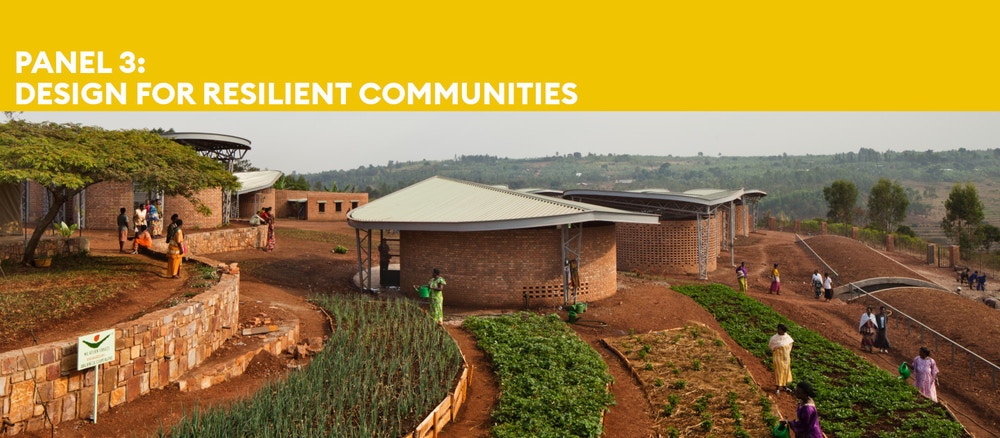PANEL 3
Panel Chairs: Anna Rubbo and Juan Du
Communities are people, and people create communities. Architects can positively impact the lives of millions, even billions, by building for the future, and creating communities that last. Resilient communities are communities that thrive, even through hardships, and are well-equipped to handle the challenges of the future.
Design for RESILIENT COMMUNITIES
A resilient community anticipates, adapts to, and recovers from adversity. Design for resilient communities encourages innovative solutions and facilitates the development of knowledge and skills necessary for adaptation and recovery.
Climate change, the global pandemic, and political upheavals in many countries have revealed social, economic, and environmental inequalities that threaten communities worldwide. These fault lines disproportionately impact the poor, people of color, the racially or ethnically marginalized and women. The 17 UN SDGs adopted by 193 countries- and the New Urban Agenda- offer an inclusive roadmap to a more sustainable future. Design for Resilient Communities seeks to encourage familiarity with the interconnections between all SDGs and targets, and how, through education, design and planning, the SDGs can enhance community resilience for specific localities and people. A key issue across Panel 3 themes is how can the SDGs be localised? Through multiple scales and perspectives, the panel will share knowledge about design research and practices that contribute positively to building resilient communities — with and for people.
Design for resilient communities requires interdisciplinary approaches to articulate these cross-sectoral issues, as well as informed co-design partnerships to achieve community-driven solutions. In addition to the actions of design and policy professionals, a key concern of this Panel is the role of research and its dissemination in accessible forms, and how design and planning education can best prepare tomorrow’s professionals to design for resilient communities. The seven sub-questions suggest themes that may guide a submission. Contributions may address more than one sub-question, or topics across sub-questions. Panel 3 submissions should demonstrate consideration — current, retrospective or future — of the aims of some SDGs and targets and, as relevant the New Urban Agenda, indicating lessons that might be adapted, replicated, or scaled up. Critical and/or theoretical approaches are welcome.
Design for Resilient Communities asks for papers that engage with these perspectives and critically explore how architecture can understand, build and fulfill its active role in achieving the UN Sustainable Development Goals (SDGs).
SUB-QUESTIONS FOR DESIGN FOR RESILIENT COMMUNITIES
3.1 THE SDGs AND EVERYDAY LIFE
Do the SDGs have the potential to engage a citizen and/or a community’s daily life and challenges, and improve their capacity to withstand, adapt or recover from adversity that may arise from social, cultural, economic, political, or climate-change events?
How can the SDGs support/guide Design for Resilient Communities and improve the lived experience of community members?
3.2 PEOPLE AS PARTNERS
How does participatory planning and inclusive co-design contribute to the Design for Resilient Communities? Under what circumstances?
How can, or how has, professional practice, collaborations with community-based organizations, educational programs and/or research increased inclusionary strategies, and have people-oriented approaches improved lives in specific situations?
Have they also strengthened local economies, protected the natural environment and biodiversity, and reduced carbon footprints?
3.3 GLOBAL CRISIS / RISING INEQUALITY
Climate change, the global pandemic and ensuing political upheavals have laid bare systemic inequalities across the world. Kate Raworth’s Doughnut Economics suggests a socio-economic-environmental pathway to sustainability. Can site-specific examples offer lessons for education, research, professional practice, and policy that will encourage better Design for Resilient Communities? How could global initiatives, such as the SDGs help address regional disparities and specificities?
3.4 LOCAL PRACTICES / GLOBAL CORPORATIONS
Can global corporations or design offices that have adopted the SDGs, or other sustainability frameworks, in their mission statements contribute to building community resilience in less developed countries through their in-country offices?
Through local collaborations, how could global practices impact local design, research, and education cultures in appropriate and positive ways, such that they contribute to more resilient communities? Are there in-country examples that, in turn, positively impact professional cultures at the global headquarters?
3.5 HOUSING AND THE RIGHT TO THE CITY
HOME BUILDING IN (UN)AFFORDABLE CITIES
The Right to the City asserts equitable access to the opportunities and resources of urban life. Today, many cities are increasingly unaffordable.
Can housing with access to urban amenities that is affordable, accessible, healthy, safe, well designed, sustainable, and proximate to urban areas be achieved? How can design professionals, researchers and city makers contribute to this seemingly intractable problem at the heart of Design for Resilient Communities?
3.6 DIGITAL DEMOCRACIES FOR EQUITABLE COMMUNITIES
Digital access and know-how have become a cornerstone of democratic life, especially in many developing countries and regions. How have new and emerging digital technologies and media contributed to positive community development and democratic processes?
In turn, how can design address digital inequalities such as those experienced in the pandemic, especially by disadvantaged groups worldwide (including children) and help create resilient communities?
3.7 ARCHITECTURAL EDUCATION IN A GLOBAL HABITAT
UNESCO’s 2022 report, Knowledge-driven actions:transforming higher education for global sustainability, advocates the take-up of the SDGs across higher education institutions. How can design and planning educators best utilize the SDGs framework?
Could the adaptation or integration of the SDGs provide the interdisciplinary knowledge and tools required to address issues of resiliency and inequality, as well as the ability to work collaboratively with communities? Past, present, or projected initiatives- studios, coursework, built projects or research – that demonstrate how the inclusion of the SDGs, the Green New Deal or other resilience strategies might throw light on these questions, are encouraged
VISIT THE SIX PANELS
Panel 1
Design for Climate Adaptation
Architecture faces a grave challenge in a world struck by climate change. The built environment must adapt to changing weather patterns, higher temperatures and flooding.
Panel 2
Design for Rethinking Resourcess
Resources are getting scarcer, and architects need to address this issue. By using novel materials and recycling on a much greater scale, architecture can change its approach to resources..
Panel 4
Design for Health
Healthy living takes place in healthy environments, and architects can help improve public health through careful planning, building and consideration.
Panel 5
Design for Inclusivity
A sustainable world is one with room and consideration for all people. Architects must design with inclusivity in mind, and take care to understand the needs of the many different people that inhabit the globe.
Panel 6
Design for Partnerships for Change
Architects must foster partnerships, and work across many different professions and skills to create a sustainable and inclusive future.


